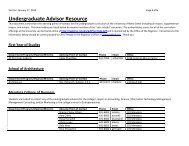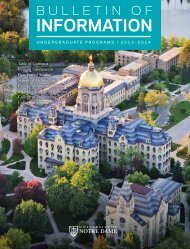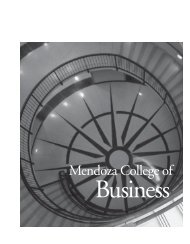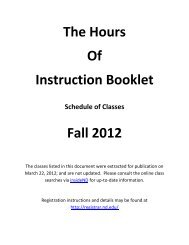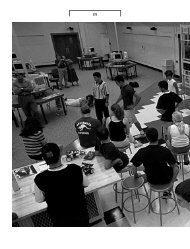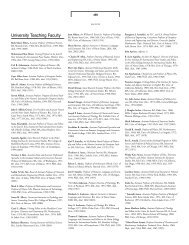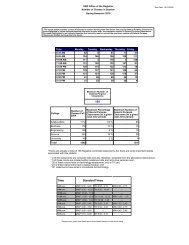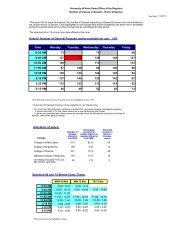258-287p 07. Engr 02-03 - Registrar - University of Notre Dame
258-287p 07. Engr 02-03 - Registrar - University of Notre Dame
258-287p 07. Engr 02-03 - Registrar - University of Notre Dame
You also want an ePaper? Increase the reach of your titles
YUMPU automatically turns print PDFs into web optimized ePapers that Google loves.
267<br />
AEROSPACE AND MECHANICAL ENGINEERING<br />
335. Intermediate Dynamics<br />
(3-0-3) Howland, Huang<br />
Prerequisites: AME 226, MATH 228.<br />
Kinematics and dynamics <strong>of</strong> rigid bodies in three<br />
dimensions, Lagrange’s equations and linear vibrations.<br />
Fall.<br />
339. Kinematics and Dynamics <strong>of</strong> Machines<br />
(3-0-3) Stanisic<br />
Prerequisites: AME 226, MATH 228.<br />
Kinematic and dynamic analysis and synthesis <strong>of</strong><br />
machinery with design applications. Fall.<br />
340. Mechanical Engineering Design<br />
(3-0-3) Staff<br />
Prerequisites: AME/CE 236.<br />
Static and fatigue failure theories. Theory, design<br />
and selection <strong>of</strong> gearing, power transmitting shafts,<br />
rolling element bearings, journal bearings, fasteners,<br />
springs, brakes and clutches. Spring.<br />
341. Computer-Aided Design and Manufacturing<br />
(1-4-3)<br />
Principles <strong>of</strong> engineering-graphic communication:<br />
visualization, sketching, orthographic projection,<br />
principal and auxiliary projections, 3D surfaces,<br />
and feature-based design. Geometric dimensioning<br />
and tolerancing, computer-integrated manufacturing,<br />
and rapid prototyping. (AME 341 will replace<br />
AME 241 beginning fall 20<strong>03</strong>.) Fall.<br />
342. Aerodynamics Laboratory<br />
(1-4-3) F. Thomas, Nelson<br />
Prerequisite: AME 250.<br />
Corequisite: AME 360.<br />
Use and operation <strong>of</strong> subsonic and supersonic wind<br />
tunnels, flow velocity, pressure and strain gauge<br />
measurements, data acquisition and analysis, with<br />
emphasis on interpretation <strong>of</strong> aerodynamic flow<br />
phenomena. Spring.<br />
343. Engineering Economy<br />
(3-0-3) Lucey<br />
A study <strong>of</strong> methods for determining the<br />
comparative financial desirability <strong>of</strong> engineering<br />
alternatives, including the use <strong>of</strong> time, various<br />
levels <strong>of</strong> cost/revenue and interest rates as<br />
parameters in the evaluation. Fall.<br />
345. Modeling and Analysis in Mechanical<br />
Engineering Design<br />
(3-0-3)<br />
Modeling and analysis <strong>of</strong> mechanical systems. Automated<br />
design decision process, introduction to<br />
statistical methods, meterial engineering, requirements<br />
definition and product specifications.<br />
346. Aerospace Structures<br />
(3-0-3) Staff<br />
Prerequisite: AME/CE 236.<br />
Study <strong>of</strong> the basic principles and methods <strong>of</strong><br />
structural analysis <strong>of</strong> lightweight structures.<br />
Introduction to stress, deformation, yielding,<br />
buckling, and fatigue/fracture analysis <strong>of</strong> truss and<br />
semi-monocoque structures, and mechanical<br />
behavior <strong>of</strong> aerospace structural methods. Fall.<br />
348. Introduction to Nuclear Engineering<br />
(3-0-3) Lucey<br />
An introduction to the various areas within nuclear<br />
engineering. Attention is paid specifically to the<br />
application <strong>of</strong> nuclear-related phenomena to the<br />
practice <strong>of</strong> engineering. Fall.<br />
350. Aerodynamics I<br />
(3-0-3) Staff<br />
Prerequisite: AME 240.<br />
An intermediate course on the study <strong>of</strong> aerodynamics.<br />
Primary emphasis is placed on the development<br />
<strong>of</strong> two-dimensional airfoil and finite-wing theories.<br />
An introduction to boundary layers is also included.<br />
Spring.<br />
355. Aerospace Measurement Systems Design<br />
(3-0-3) P. Dunn<br />
Individual and team-based design, fabrication,<br />
calibration, and implementation <strong>of</strong> on-board measurement<br />
systems for remote data acquisition. Emphasis<br />
is placed on developing a sensor/<br />
microprocessor/memory system that will be used in<br />
the subsequent senior aerospace design project in<br />
AME 441.<br />
360. Aerodynamics II<br />
(3-0-3) Staff<br />
Prerequisite: AME 350 or AME 334, or AME 327.<br />
An intermediate course <strong>of</strong> the study <strong>of</strong> the dynamics<br />
and thermodynamics <strong>of</strong> compressible flow for<br />
both internal and external geometrics, including<br />
boundary layer effects. Applications <strong>of</strong> compressible<br />
flow principles to propulsive nozzles, flight<br />
simulation facilities and supersonic airfoil problems.<br />
Spring.<br />
366. Orbital and Space Dynamics<br />
(3-0-3) Howland<br />
Prerequisite: AME 226.<br />
The one- and two-body problems: geometrical<br />
elements and time dependence. Orbital determination.<br />
Linear orbits and regularization. Orbital<br />
transfer. The n-body problem; various forms <strong>of</strong> the<br />
three-body problem, including the circular restricted<br />
case, its “equilibrium” solutions and their<br />
stability. Spring.<br />
370. Manufacturing and Assembly<br />
for Aerospace Systems<br />
(3-0-3) Renaud, Batill<br />
Prerequisite: AME 225.<br />
An introduction to processes and techniques associated<br />
with the component manufacturing and assembly<br />
for lightweight structures. Issues related to<br />
material processing, assembly, CAD and CAM as<br />
well as additional topics in manufacturing such as<br />
rapid prototyping, tolerancing and quality will be<br />
introduced. Spring.<br />
425. Vibrations<br />
(3-0-3) Howland, Skaar<br />
Prerequisites: MATH 325, AME 226.<br />
Free, steady and transient response <strong>of</strong> linear single<br />
and multiple degrees <strong>of</strong> freedom systems. Viscous<br />
damping, dry friction damping, energy methods<br />
and numerical techniques. Fall.<br />
430. Road Vehicle Dynamics<br />
(3-0-3) Staff<br />
Prerequisite: AME 226.<br />
Introduction to the operation <strong>of</strong> vehicle subsystems<br />
such as transmissions, engines, brakes, suspensions,<br />
etc. Calculation and simulation <strong>of</strong> vehicle performance,<br />
handling and comfort. Discussion <strong>of</strong> industry<br />
technical standards, vehicle safety, restraint<br />
systems and federal safety standards. Not every<br />
year.<br />
435. Statistical Quality Methods<br />
(3-0-3) Brach<br />
Prerequisite: MATH 225.<br />
Topics covered include statistical concepts such as<br />
population, probability distribution, mean, variance,<br />
samples and data treatment; also, statistical<br />
process control including process control charts<br />
and process capability; introduction to design <strong>of</strong><br />
experiments and Taguchi methods. Fall.<br />
437. Control Systems Engineering<br />
Prerequisites: MATH 325, AME 226.<br />
(3-0-3) Goodwine<br />
Application <strong>of</strong> modeling, feedback analysis and<br />
design to mechanical, thermal, electrical and fluid<br />
systems, including classical control theory in the<br />
frequency and time domains. Stability, performance<br />
and methods based on root-locus, Bode and<br />
Nyquist diagrams. Representation in state space<br />
and basic state space design. Spring.<br />
438. Intermediate Fluid Mechanics<br />
(3-0-3) Staff<br />
Prerequisite: AME 334 or AME 360.<br />
A second course in fluid mechanics, including<br />
potential flow, viscous flow, thermal convection,<br />
compressible flow and advanced topics. Fall.<br />
439. Heat Transfer<br />
(3-0-3) Staff<br />
Prerequisites: AME 327, AME 334 or AME 350.<br />
An introductory course covering three modes <strong>of</strong><br />
heat transfer: steady and unsteady conduction,<br />
elementary boundary layer analysis for laminar and<br />
turbulent convection and the basic theory <strong>of</strong> radiation.<br />
Spring.<br />
440. Flight Mechanics and Introduction to<br />
Design<br />
(3-0-3) Staff<br />
Prerequisite: AME 350.<br />
The fundamentals <strong>of</strong> flight performance are<br />
developed. Primary emphasis will be on examining<br />
how configuration design parameters affect aircraft<br />
performance. Students are introduced to aircraft<br />
preliminary design methodology. Fall.<br />
441. Aerospace Design<br />
(2-4-4) Batill<br />
Prerequisite: AME 440.<br />
Team design project with application to an aerospace<br />
system development. Includes topics in all<br />
associated technologies, design methodology, standards<br />
and engineering ethics. Spring.






